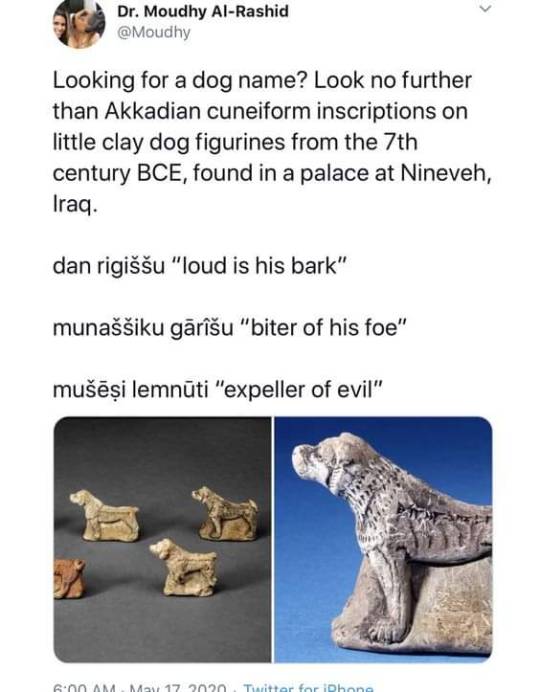#cuneiform
Text

Sumerian foundation figure, dating back to the Early Dynastic period around 2900–2350 BCE. The Pergamon Museum, Berlin, GERMANY.
Photo by Babylon Chronicle
253 notes
·
View notes
Text
A lost Canaanite language called Amorite has been decoded thanks to the discovery of bilingual tablets, similar to the way the Rosetta Stone helped scholars decipher Egyptian hieroglyphs.
The tablets were written in Amorite and Akkadian using the cuneiform script. Prior to the discovery of these tablets there was such little written evidence for Amorite that some scholars doubted whether it even existed. Amorite was a Canaanite language related to Hebrew, in the Semitic language family.
Pretty cool, Amorite? 😅
490 notes
·
View notes
Text
“You shit bucket of a farter!” (SAA 3 30)
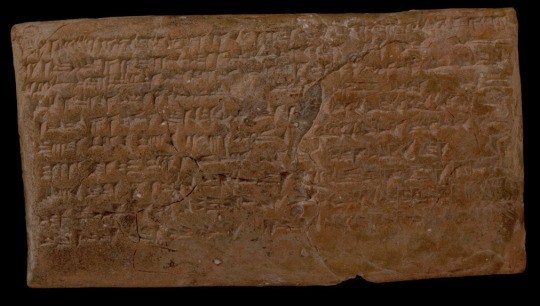
This ancient Neo-Assyrian "diss track," framed as a magical incantation, offers a series of slurs (some misogynistic and homophobic) against a Mr. Bel-eţir. It seems to conclude with an aggressive invitation: “fight me!”
There are multiple Bel-eṭirs in the historical record, but this is probably the same son of Ibâ who had a satire of a birth-legend written about him.
Although the tablet is well-preserved, many of the phrases are obscure; I have used italics to indicate where I am less certain of my translation.
...
Incantation:
Mr. Bel-eṭir, you twofold prison fucktoy, twofold soggy, twofold staring, son of Ibâ, absent epoch, shit bucket of a farter, second-rate clan, slave of a dead god, house whose star has vanished from the sky, maidservant, woman, slave of Lady Balihitu, beard among fucked-out women, "Mr. Baby-boy," much-maligned man.
Mr. Ammanappu provided your whitewash, saying: "First of all, his house is in shadow, starting at the top." He swore by the Lord, "I will not let go until I have fucked him!"
Let go of what Mr. Ammanappu has! Don't chase after what Mr. Tamru has! Stay away from Mr. Ammanipite! Keep your crotch away from Mr. Haimbi!
Now I have spoken to you. On account of this, rise up against me!
4K notes
·
View notes
Photo
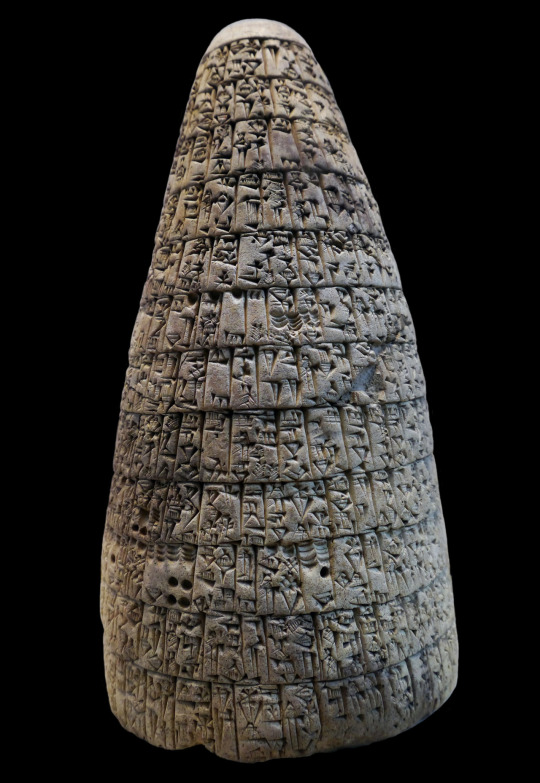
Cone of Urukagina, king of Lagash, circa 2350 BC,
Girsu, Mesopotamia,
Detailing his reforms againt abuse of "old days".
Height: 27 cm (10.6 in); diameter: 15 cm (5.9 in).
Collections of the Louvre (Department of Near Eastern Antiquities).
#art#design#sculpture#writing#words#king of lagash#girsu#mesopotamia#le louvre#cone#urukagina#styl#history#ideographic#cuneiform#sumerian
841 notes
·
View notes
Text

The Sennacherib prism, commissioned by the Assyrian king in the 600s BCE. Its ten sides contain records of his conquests and achievements in cuneiform. The record culminates with Sennarcherib's 15-month siege and destruction of Babylon.
{WHF} {Ko-Fi} {Medium}
434 notes
·
View notes
Text
Searching on AO3 and...
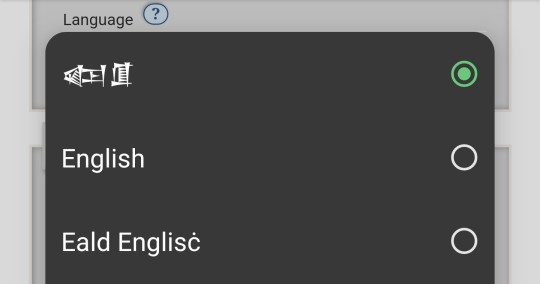
I just need to know who's writing fic using cuneiform and Old English
2K notes
·
View notes
Text


Classicstober Day 14: Helen (𐀁𐀩𐀛/𒄭𒇷𒉌)
Helen of Troy… Helen Queen of Sparta… Helen Princess of Sparta… Helen the daughter of Leda and Zeus… the face that launched a thousand ships wore many masks over the course of her life but one thing that remains the same is how compelling she remains as a character. Many thanks to @symeona for helping me with her look!
Helen is a character intrinsically associated with her appearance, but early sources do not describe her at all outside of demonstrations of her status. For this piece, I have borrowed from two sources. The first is symeona, who's excellent translations on Ancient Greek color theory informed my take on Achilles. The second was that wretched and accursed fnckboy Ovid, who described Helen's mother Leda as having 'snowy white' skin and black hair. Since Zeus appeared to Leda in the form of a swan, and considering how pale Leda was, I decided to make her somewhat swan-like in appearance, with big black eyes and naturally ruddy lips to seal the deal.
First, let's talk about Helen the Spartan (rendered here in Linear B as 'Eleni of Laconia'). Despite mainly being known for her role in the Trojan War, Helen lived the majority of her life in Sparta and her husband Menelaus claimed the throne of Sparta through her. Laconia and Sparta are some of the oldest sites of Mycenaean culture, so Helen got to be depicted as Mycenaean as all getout. The high-piled hair, the diadem, the open tunic, and the bracelet are all very common in depictions of Mycenaean and Minoan women. She also has very elaborate florets to mark her status. The red fabric and large gemstones mark her wealth too i completely forgot to draw in the necklace she wore in the sketch version.
I mentioned before in my picture of Cassandra and Hector that I am basing the Trojan looks heavily on ancient Hittite clothing, and this is no exception. I know the movie Troy sucks for lots of reasons, but I did like that they made the Trojan theme color this very rich blue so I decided to add that here; dark, rich colors in general are very expensive to produce, so even if it's not red the saturation makes the cloth very expensive and a mark of royalty. I based her clothing and jewelry off a Hittite statue, but I decided to omit the tall hats that Hittite women appear to wear under their veils; I kind of wanted that to represent status, so only Andromache and Hecuba would wear the tall hats if I depict them.
I was not trying to make a commentary with it, but it does strike me how conservative the veiled, tunic wearing Hittite woman looks compared to the open-bodiced Mycenaean woman. That could easily be read into, but I'm just going to leave it as depiction and not try to ascribe any symbolism to it.
The decorative circle around Helen represents several things. Horses feature prominently in her life. The Trojan Horse is the most well known, but the wedding oath that Tyndareus made Helen's suitors swear to was sealed with the sacrifice of a horse too. Anemones are a sacred flower to Aphrodite (long story) and the white lilies seem like a fun way to evoke the 'pure woman' image.
Also in the circle are depictions of Eris' golden Apple of Discord. For the life of me, I could not find any translation related to fairness or beauty in any Mycenaean dictionaries so I had to cheat: "𐀴 𐀏𐀪𐀯𐀳𐀂/ti ka-ri-se-te-i" is just a phonetic transliteration of ΤΗΙ ΚΑΛΛΙΣΤΗΙ (tē(i) kallistē(i)), translated as 'for the fairest.'
#classicstober#classicstober2023#classicstober23#helen of troy#helen of sparta#greek mythology#ancient greek mythology#tagamemnon#linear b#mycenaean#hittite#hittite cuneiform#cuneiform
156 notes
·
View notes
Text
What is cuneiform?
@ipsomaniac asked if I could explain the cuneiform system, and so I am going to give it a shot. Here goes! (Update: it got long! But there's pictures!)
Part I: What does it look like? How do we work with it?
This is the cuneiform script:
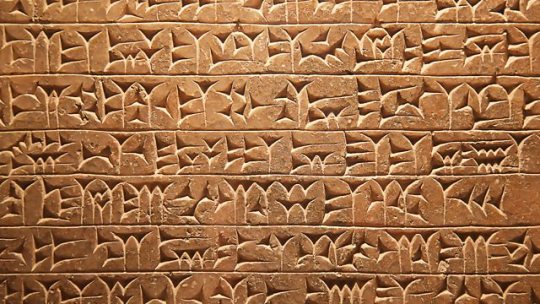
This is a first-millennium BC text of Sargon II, in Akkadian (specifically Neo-Assyrian). My user icon is a much older Sumerian text. In a second we'll see some Hittite. Just like the Latin script is used for English, French, Turkish, and many other languages today, the cuneiform script was used for lots of languages in the ancient world. It changed a bit over three thousand years of constant use, but it remains pretty recognizable because of the wedges. "Cuneiform" is just Latin for "wedge-shaped," because scholars love giving things banal names and then translating them into Latin or Greek so no one can tell.
This is a Hittite tablet:

This particular tablet is part of the royal funerary ritual (which has many many MANY tablets, many of which are way more broken than this one, and/or missing entirely). It's been pieced together from lots of fragments, all excavated separately. (You can see their excavation numbers written on the fragments, e.g. 39/c.) It's written on clay, like most of their texts were. This is a pretty good amount of preservation for a tablet this size - many are more fragmentary. I wish the picture were better, but tablets are not catalogued by how good the pictures are and it would have taken a million years to find a really hi-res one suitable for our purposes.
You can see that each symbol is made up of a bunch of wedges. These were pressed into the clay with a stylus while it was still wet. If you look closely, you can also spot spaces between words (more obvious at the end of a paragraph).
Here's a little slice of our tablet:

And here's a drawing of that same little slice. This is how scholars usually interact with texts on a day-to-day basis, because taking readable photos of tablets is difficult and going to see the tablets is more difficult. Drawings are made by experts in the presence of the tablets and published so that everyone can look at them.
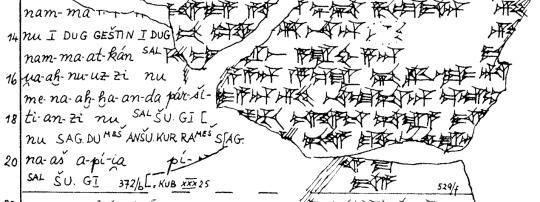
Here the scholar who did this drawing (published in Keilschrifturkunden aus Boghazköi vol. 39, text no. 4) was working with only some of the fragments, and so has written in the transliteration of the left half, which they weren't copying. So you can see how each cuneiform sign corresponds to a written syllable, sometimes in lowercase, sometimes in all caps, and sometimes in superscript.
What does all this mean? How does it work? Okay. Cuneiform is a really difficult and frustrating writing system to read, for a few reasons. 1) It grew organically from a time before writing existed, so people were just kind of slowly figuring out how to use pictures to represent words; 2) it lasted for thousands of years, so there were all sorts of innovations tacked on without necessarily jettisoning any of the old stuff; and 3) it was borrowed through quite a few languages, almost none of which were related to one another, so it had to twist around and adapt to totally different sounds and word structures. So it's weird! And hard to learn, especially for us, because we are not native speakers of any of the languages that used it, and also we're not a single person existing in a snapshot of time, where cuneiform had a specific form and iteration - we're looking at its whole span of three thousand years.
THAT SAID. I can explain some stuff about it and how it worked! Here goes!
Part 2: How does it work as a writing system?
We start with a picture. Let's use a star. Like this: 𒀭
Or this:
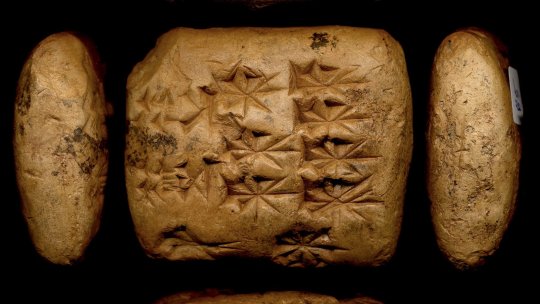
(this is a student text copying the star sign over and over - ignore the leftmost column. I got it from this excellent thread here)
This is the cuneiform sign for the sky, or for a god. In Sumerian, the language that first used cuneiform, the word for "sky" is AN. The word for "god" is DINGIR. So this sign could be pronounced either AN, and mean sky, or DINGIR, and mean god. This sort of usage is called "logographic" - a sign equals a word. It started as just a picture of a star, and came to mean a couple of things associated with the stars.
Eventually, there reaches a point where it doesn't just only mean the word "sky," it also means the syllable "an." That is, you could use it to represent a part of a word, or a grammatical element, that was pronounced "an." (E.g., ma-ah-ha-an: mahhan, which is a Hittite word that means "when," and which is written with four signs, including our an.) This is called the rebus principle: like a rebus puzzle, a picture of an eye can also mean "I" because they sound the same. This usage supplements the logograms rather than replacing them: you could still use "an" to mean "sky." You know which usage is in play based on context. (Or at this stage, maybe you don't. Sumerian is real hard and we don't understand it perfectly.)
You can also use signs a third way, which is designed to make reading easier: as what's called a "determinative." A determinative tells you what type of thing a word is. So if you use the star symbol as a determinative, it comes before a word and indicates that upcoming is a god's name. It's not pronounced when it's used like that. Other determinatives include: male and female markers, plural markers, markers to indicate what something is made of, what kind of animal it is, etc.
So any sign you see could potentially be a word (logogram), a sound (syllable), or a soundless classifier (determinative). In practice, only some signs take on all three of these functions.
When we transcribe signs now, we write them in Latin script based on which function they're serving. That's why, in the above Hittite texts, some of the signs were written in all-caps (for logograms), some of them in lowercase (for syllables), and some of them in superscript (for determinatives).
So then Akkadian borrows the system. They like to spell words out a lot more than the Sumerians do, so more and more signs are used primarily for their syllables, rather than their meaning. The signs also take on more syllabic meanings, because Akkadian has different words behind the logograms, and also has different sounds than Sumerian. A lot of signs end up doing double, triple or even-more-ple duty (e.g. the sign for "ag" can also be read "ak" or "aq" in an Akkadian text). Once again, you know how to read a sign from context, and in Akkadian you usually actually do know, because Akkadian is a Semitic language rather than an isolate like Sumerian, so we understand it way, way better.
Akkadian keeps using the symbols as logograms, though, too. Sometimes they'll spell out a word, but sometimes they'll just use the logographic symbol for it - like how sometimes we write out "two," and sometimes just write "2". Sometimes there are full Sumerian words or combinations of words that have become logograms: that is, they're not loanwords. They're not pronounced in Sumerian. They're written as a symbol (like 2), and the Akkadian word would be pronounced underneath (like "two.") The Akkadians also keep using determinatives.
At this point, most signs at least have a logographic value and a few syllabic values. Also (to make it extra difficult) plenty of syllables have a couple of different signs that could be used to represent them. In total there's a bit over a thousand cuneiform signs, incidentally, but usually only a few hundred were in use at any given time and place.
Then Hittite borrows it! They actually overall reduce the number of signs used, and the number of signs doing double duty, so it's generally simpler to read. Hittite's sound system is totally different from Akkadian's, though - which is totally different from Sumerian's - so they do some weird stuff with which signs represent which sounds. (The result of this is that our understanding of Hittite phonetics is somewhat imperfect.) They do use a ton of logograms whenever they're talking about physical objects, especially ritual offerings. Ritual texts are A PAIN IN THE ASS to read because they're full up with obscure logograms, and so you pore over a signlist trying to work out what the bonkers twelve-wedge sign you've never seen before is, and then when you finally find it you're like, "oh ANOTHER kind of bread. cool cool."
Part 3: Let's Read Hittite! (This is probably excessive.)
So finally, let's read some together! This is two lines from the Ten-Year Annals of Mursili II, an account of the first ten years of that king's reign. It's mostly conquering, but this bit is calmer.
(ANNOYINGLY, Tumblr will not do superscript, or I cannot make it anyway, so I will put determinatives in parentheses.)

nam-ma (URU)Ha-at-tu-ši ú-wa-nu-un nu (URU)Ha-at-tu-ši
gi-im-ma-an-da-ri-nu-un nu-za EZEN4.HI.A ŠA MU.6.KAM i-ya-nu-un
That's the text rendered sign-by-sign. Everything that is separated by a dash, a period, a space, or a parenthesis is a separate sign. Words are separated with spaces. Here's a more normalized rendition of the words (still with the logograms, though).
namma (URU)Hattusi uwanun nu (URU)Hattusi gimmandarinun nu=za EZEN4.HI.A ŠA MU.6.KAM iyanun
"Then I went to Hattusa, and I spent the winter in Hattusa and performed the festivals of the sixth year."
The ú in uwanun in the first line is written with an accent because there are several signs that can mean "u" and this is the second one. Similar for EZEN4: there's more than one sign for EZEN, and this is the fourth. Scholars always write logograms and determinatives in Sumerian, because that's where the meanings were fixed. URU, used before Hattusa, is both the determinative for "city" and the Sumerian word meaning the same. ŠA in the last line is italicized and capitalized because it's a logogram that comes from Akkadian: "ša" means "of" in Akkadian, and the Hittites used Akkadian words as logograms just like the Akkadians used Sumerian words.
Anyway, that's how cuneiform works! If you made it this far you're a hero! <3
118 notes
·
View notes
Text
Lingthusiasm Episode 88: No such thing as the oldest language
It's easy to find claims that certain languages are old or even the oldest, but which one is actually true? Fortunately, there's an easy (though unsatisfying) answer: none of them! Like how humans are all descended from other humans, even though some of us may have longer or shorter family trees found in written records, all human languages are shaped by contact with other languages. We don't even know whether the oldest language(s) was/were spoken or signed, or even whether there was a singular common ancestor language or several.
In this episode, your hosts Gretchen McCulloch and Lauren Gawne get enthusiastic about what people mean when we talk about a language as being old. We talk about how classifying languages as old or classical is often a political or cultural decision, how the materials that are used to write a language influence whether it gets preserved (from clay to bark), and how people talk about creoles and signed languages in terms of oldness and newness. And finally, how a language doesn't need to be justified in terms of its age for whether it's interesting or worthy of respect.
Read the transcript here.
Here are the links mentioned in the episode:
Lingthusiasm episode 'Tracing languages back before recorded history'
'My Big Fat Greek Wedding- Give me any word and I show you the Greek root' on YouTube
Glottolog entry for 'classical'
Wikipedia entry for 'Complaint tablet to Ea-nāṣir'
Wikipedia entry for 'Bath curse tablets'
Wikipedia entry for 'Cuneiform'
Wikipedia entry for 'Mesopotamian writing systems'
Wikipedia entry for 'Home Sign'
Lingthusiasm episode 'Villages, gifs, and children: Researching signed languages in real-world contexts with Lynn Hou'
Wikipedia entry for 'Al-Sayyid Bedouin Sign Language'
Wikipedia entry for 'Kata Kolok' (also known as Benkala Sign Language)
True Biz by Sara Nović on Goodreads
Gretchen's thread about reading True Biz
You can listen to this episode via Lingthusiasm.com, Soundcloud, RSS, Apple Podcasts/iTunes, Spotify, YouTube, or wherever you get your podcasts. You can also download an mp3 via the Soundcloud page for offline listening.
To receive an email whenever a new episode drops, sign up for the Lingthusiasm mailing list.
You can help keep Lingthusiasm ad-free, get access to bonus content, and more perks by supporting us on Patreon.
Lingthusiasm is on Bluesky, Twitter, Instagram, Facebook, Mastodon, and Tumblr. Email us at contact [at] lingthusiasm [dot] com
Gretchen is on Bluesky as @GretchenMcC and blogs at All Things Linguistic.
Lauren is on Bluesky as @superlinguo and blogs at Superlinguo.
Lingthusiasm is created by Gretchen McCulloch and Lauren Gawne. Our senior producer is Claire Gawne, our production editor is Sarah Dopierala, our production assistant is Martha Tsutsui Billins, and our editorial assistant is Jon Kruk. Our music is ‘Ancient City’ by The Triangles.
This episode of Lingthusiasm is made available under a Creative Commons Attribution Non-Commercial Share Alike license (CC 4.0 BY-NC-SA).
#linguistics#language#lingthusiasm#episodes#podcast#podcasts#episode 88#language history#oldest language#classical languages#ancient languages#sign language#home sign#cuneiform#writing technology#writing systems#SoundCloud
120 notes
·
View notes
Note
What does this actually mean?
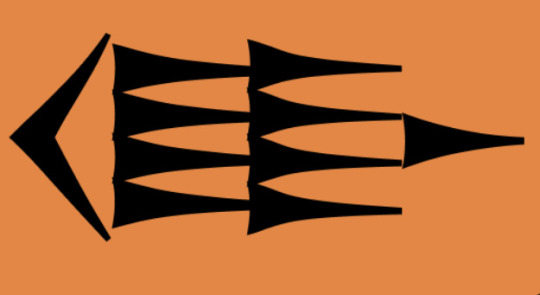
Its a new tumblr badge
Hello! This is the sign 𒂂 dugud, which has several meanings including "weight, heavy, massive", "cloud" and "important, to be important". I assume it's being used in the latter meaning, designating the person as important here on tumblr dot com!
217 notes
·
View notes
Text

388 notes
·
View notes
Text

NEWS
Cuneiform Tablets in Mesopotamia Reveal the Strength of the Ancient Geomagnetic Field
https://www.archaeologs.com/n/cuneiform-tablets-in-mesopotamia-reveal-the-strength-of-the-ancient-geomagnetic-field
79 notes
·
View notes
Text
During excavations at the ancient Hittite capital, Hattusa, archaeologists have found a clay tablet that contains a previously unknown language!
107 notes
·
View notes
Text

Line drawing of an impression from the cylinder seal of Shar-Kali-Sharri, ruler of the Akkadian Empire ca. 2217-2193 BCE. On the right of the impression, the hero Gilgamesh wrestles with a lion. From The Seal Cylinders of Western Asia by William Hayes Ward, published in 1910.
#art#art history#ancient art#Ancient Near East#Mesopotamia#history#ancient history#Akkadian#Akkadian Empire#Shar-Kali-Sharri#cylinder seal#cuneiform#Gilgamesh
49 notes
·
View notes
Text
wrt the new ea-nāṣir bracelet: so they chose the old persian template, which is the wrong cuneiform tradition to go with, and not (just) because that makes it the wrong time period by about 1300y, but mostly – in this case – because OP cuneiform doesn't lend itself to adaptation into latin characters nearly as well as babylonian would have
the Y just looks entirely wrong. OP cuneiform doesn't have diagonal wedges – maybe the word divider could count, but that's only top-left down-right diagonal 𐏐 so even for V, for example, you would have to combine the diagonal with a vertical wedge 𐏐𐏑 if anything. for Y, none of the options with diagonal wedges look ok because there is no short diagonal wedge; they should have probably gone with the '100' sign instead: 𐏕
babylonian cuneiform has many more signs with much more varied shapes so making something resembling the latin alphabet out of it would've just been so much easier 🙄
219 notes
·
View notes
